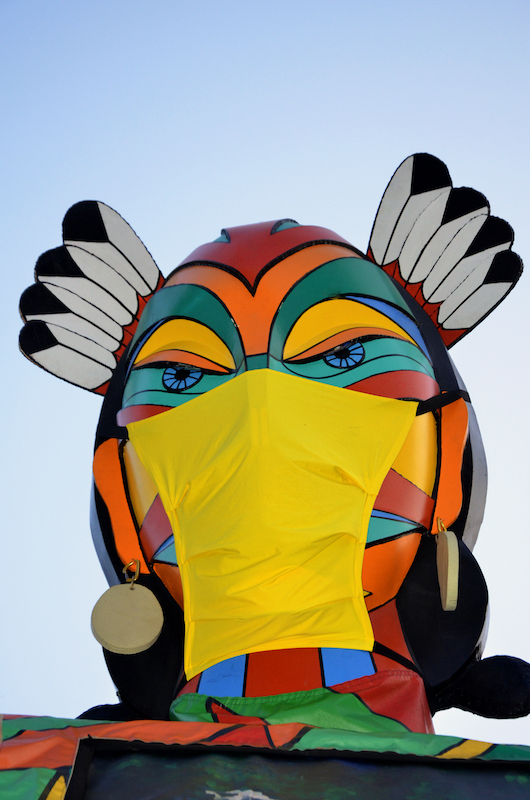Montreal’s First Peoples Festival once again delivered an impressive array of Indigenous films, live concerts, theatre and visual arts after going mostly virtual last year. The festival, which ran August 3-11, included a “daily occupation” of the Place des Festivals for five memorable evenings.
Every afternoon during the festival, the Buffalo Hat Singers and Northern Voice traditional music groups gave impromptu performances, while the NuestraAmericana parade on Saturday afternoon offered an opportunity for Indigenous cultures from countries like Mexico and Colombia to display traditional cultural dances and regalia.
“In the 21st century, we open our minds and hearts to our Indigenous brothers and sisters all around the world,” festival director André Dudemaine told CBC. “The best ambassadors for a nation are the artists because they have a language that everybody will automatically connect to.”
The first night of concerts was a daring collaborative experiment, with Nouvel Ensemble Moderne and Forestare providing a contemporary classical backdrop for rising stars Laura Niquay, Anachnid and Q052. Pikogan rapper Samian launched his album on August 6, while Mike Paul and Gator Beaulieu gave rootsy performances the following night.

After a year of pandemic-enforced online shows, Twin Flames began their show by remarking, “Wow, real people!” The award-winning band delivered energy and showmanship with songs in English, French and Inuktitut, including their powerful Indigenized cover of the Tragically Hip’s “Grace Too”.
On August 8 and 9, Véronique Basile Hébert presented Notcimik (Where Our Blood Comes From), poetic experimental theatre that honoured Nitaskinan, the ancestral territory of the Atikamekw. Aligned with her culture’s tradition, the playwright explored the sources of her belonging by equating Nitaskinan’s land and rivers with flesh and blood.
On August 9, the International Day of the World’s Indigenous People, Eruoma Awashish launched her new book as her illustrations were presented on giant downtown panels. The artists who created L’enclos de Wabush, a play by Louis-Karl Sioui that was webcast in June, also participated in a screening followed by a meeting with the public.
Over 60 films were screened in competition for the coveted Mattiusi awards, with Brazil’s Luiz Bolognesi winning the Teueikan Prize for A ultima floresta (The Last Forest). The Rigoberta Menchú Award went to the Mexican production ¿Qué les pasó a las abejas? by Adriana Otero and Robin Canul, with Carol Kunnuk’s Ataguttaaluk taking second prize.
Kim Obomsawin won the APTN award for her meditative film Joséphine Bacon: I am Human, with special mention for Tracey Deer’s Beans. Best documentary went to Roberto de la Puente’s Quchiwato maldito while Roxann Whitebean won the Main Film International Aboriginal Achievement Award for her first feature, Haudenosonee Canoe Journey.
“It was very exciting to be selected as an international emerging filmmaker,” Whitebean told the Nation. “It’s very encouraging for me as an artist. I liked how the audience responded in the Q&A, interested in how we battled the elements. A lot of people tell you it’s difficult to work with children, animals and on water – I did all three.”
Screened at the Cinéma du Musée during the festival, Whitebean’s documentary follows Hickory Edwards and his five-year-old daughter Ellirose as they traverse traditional water routes long forgotten by their people. Whitebean said she had romanticized how it would be, before quickly realizing how the land had been impacted by colonization as much as her people in Kahnawake.
“We lost our connection to our land due to colonization,” said Whitebean. “I thought this is a positive Indigenous role model and an important story. Every year the canoe journey grows – there were a lot of people who participated this year because they became interested in the story and experiencing the ancient waterways of the Haudenosaunee people.”
Among the other film winners was Jarret Twoyoungmen, who took Best Canadian Short Film for Nâdu, which documents the importance of hair in Nakoda cultural traditions. He was inspired by Badria Abubaker’s short film Black Hair, which similarly seeks to educate non-Native people about cultural aspects that are often misunderstood.
“I do it for education purposes for non-Native people and other youth who don’t know anything about traditional cultures,” Twoyoungmen told the Nation from his home in Morley, Alberta. “Abubaker taught me that films should be used to educate other people. Now I’m making one about teepees. It’s weird winning something – hopefully it’ll inspire other filmmakers and rez kids.”
Back on the opening night of the First Peoples Festival, the films Ashes and Embers by Alix Van der Donckt-Ferrand, written and narrated by Floyd Favel, and Ataatatsiaq (Grandfather) by Lisa Koperkualuk were presented at the Imperial Cinema in the presence of the three documentary filmmakers. Favel, who is Cree from the Poundmaker First Nation, said he was impressed by the festival’s knowledgeable staff and the high production quality of this year’s films.
“Because they invited us all this way, in brotherhood and sisterhood we thought we should try to take in as many events as we were able to while we’re here,” Favel said. “The whole purpose of festivals is to network and support each other. It’s also the ongoing development of our own film and cultural industry. We need that alongside working with the mainstream cultural and film industry.”
Ashes and Embers documents a residential school near his First Nation that was burned down by students in 1948 “in an act of resistance and liberation.” Favel said the sophisticated storytelling in the Brazilian films he watched was a learning experience for him to continue developing and challenging his own work.
“The downtown festival venue is the perfect place,” Favel commented. “It reintroduces Indigenous cultures back to that historic area that was a major trading centre before colonization. Tribes were always there with their songs, dances and art. It’s good to see it as strong as ever, giving us a platform to show to the world our contemporary and traditional art.”





